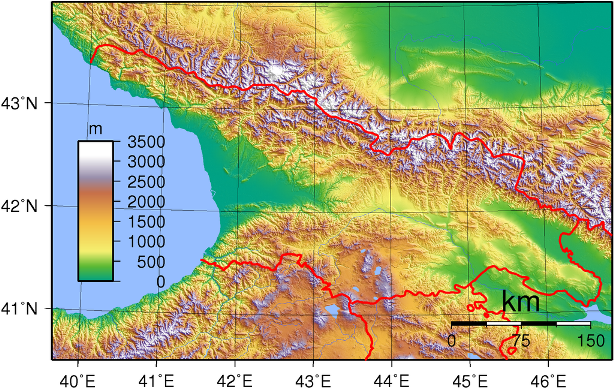Geopolitical position
Georgia is located on the ancient crossroads of Europe and Asia, which is known as the Caucasian isthmus.
Immediate neighboring countries of Georgia are such CIS countries as the Russian Federation, Azerbaijan, Armenia and Turkey, which is a member of NATO.
Georgia is located in such geopolitical region where Christian and Muslim worlds are closely interwoven.
After the collapse of the Soviet Union, Georgia's geopolitical situation has changed dramatically. Earlier, Georgia was in the transport impasse. But now, the shortest way from Middle and Central Asia to Europe runs through Georgia.
Transport and geographical location
The transport complex is one of the most important sectors of the Georgian economy.
Batumi and Poti Ports, which are located on the Black Sea, give opportunity to connect with any other ports on the Black Sea and the Oceans.
It is also important that the Danube River flows into the Black Sea - the most important transport artery of Eastern and Central Europe.
Land transport on the territory of Georgia is mainly represented as rail and motor transport. Transport routes that connect north and south countries are very important for Georgia. Roads from Armenia, and mainly from Turkey, to Russia run through Georgia.
Physiographic location
Georgia is located in the central part of the Alpine-Himalayan mountain belt.
Almost all types of subtropical climate zone - a humid subtropical climate, moderately moist, moderately dry and dry continental – are formed in Georgia.
Due to placing on the isthmus, which connects Europe and Asia, different habitats of flora and fauna coexist well in Georgia. Natural conditions of plains in West Georgia differ from the plains of Eastern Georgia, and the nature of the Caucasus Mountains differs from the natural mountain environment of South Georgia.
Almost all types of soil, existing in the world, are presented in Georgia. The country is even called "The Museum of Soils."
Air temperature
The air temperature in Georgia has a distinct seasonal variation.
In January, the highest temperatures are observed in the Colchis lowland and adjacent foothills –here the temperature is about +4 ° +6 °. It is especially warm in Batumi (+7 °). In eastern Georgia it is colder. January temperature in the plains is about -1 ° +1 °.
The lowest average temperatures are on the meteorological station Kazbegi (-42 °) and Akhalkalaki plateau (-41 °).
Summer in the East Georgia is warmer than in the West.
In Tbilisi, the absolute maximum temperature is +40 °, and minimum is -23 °.
Lakes and rivers
• The main watershed of Georgia is the Surami Ridge, which separates basins of the river Mtkvari from the rivers of West Georgia. The Mtkvari River flows into the closed Caspian Sea, and the rivers of West Georgia - in the Black Sea.
• There are 850 lakes. Their total area is 169 sq.km.
Main rivers of Georgia Lakes (mostly important), surface area in sq.m.
Peaks
Shkhara: 5068 m (16,627 ft)
Mkinvartsveri (Kazbek): 5047 m (16,558 ft)
Shota Rustaveli: 4860 m (15,944 ft)
Tetnuldi: 4858 m (15,938 ft)
Ushba: 4700 m (15,419 ft)
Aylama: 4547 m (14,917 ft)
Flora and Fauna
• Flora of Georgia is rich and various. Exact number of species found in Georgia cannot be specified. |It counts approximately13,300 species. 4,225 species of them are seed-bearing plants.
In Georgia we have 380 endemic plants, found only in our country.
Forest vegetation in Georgia is widespread. Forests cover one-third of the country.
• The fauna of Georgia is diverse. Here you can find about 100 species of mammals, 330 species of birds, 48 species of reptiles, 11 amphibians, and up to16 – species of fish. Besides, there are thousands of species of invertebrates, the exact number of which has not been established yet.
Among the animals you can find both endemic species, as well as species widely distributed in temperate and subtropical latitudes of Eurasia.
The Red Book of Georgia
The Red Book of Georgia was printed in 1982. It listed information on 65 rare and endangered species. It also listed information on 161 species of plants. The Red Book contains information on 77 sites of inorganic nature (geologic-morphologic and hydrographic).



